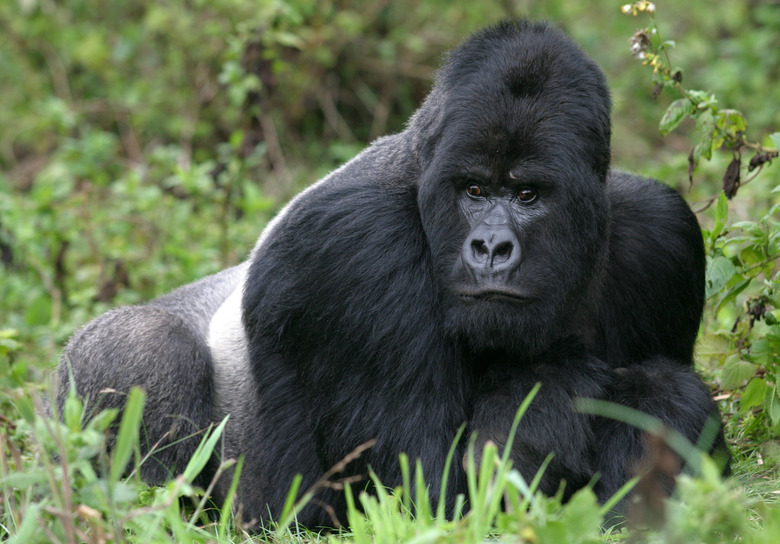The Silverback Gorilla's Diet
The characteristic silver hairs on the backs of some mountain gorillas indicate they are adult males. As extremely powerful, large primates, nearly 400 pounds, compared to their female counterparts at a mere 200 pounds, silverback gorillas live mostly in the jungles that surround African mountain ranges. To sustain a body that size, silverback gorillas need to eat a lot of food every day, and make sure they get all the right nutrients into their systems.
Primary Diet
Primary Diet
The bulk of the mountain gorilla diet is vegetation. They eat a lot of shoots, leaves and plant matter. There are actually about 142 varieties of plants represented in the silverback's diet, including bamboo, celery, nettles, thistles and succulent herbs. When they can get them, they also love to eat any wild berries they can find. To sustain their weight, they need to eat about 60 pounds of food every day.
Occasional Foods
Occasional Foods
Occasionally, the silverback will also eat grubs or bugs. If the gorillas happen to find a wild ant nest, they will break into it and eat the ants inside. Silverbacks also eat rotting wood and small animals from time to time. Though their primary diet consists of much easier-to-find vegetation, the silverback gorilla, like humans, are an omnivorous species: they can eat meat or plants as they choose.
The Water in Bamboo
The Water in Bamboo
In the jungle, water is not extremely easy to find in pools or streams. Fortunately, gorillas are not actually affected by this because their diet includes bamboo shoots, succulent herbs, and many fruits which contain a lot of water. Bamboo, especially, is about 84 percent water. In the 60 pounds of vegetation they consume daily, there is enough water to sustain the gorilla, especially during the rainy season.
Feeding Habits
Feeding Habits
Gorillas have three main feeding periods each day to reach the approximately 60 pounds of food they need. Between these periods, they generally spend the remaining part of the day resting. They will rest longer when it's raining heavily, putting off their next meal until the weather calms down. Silverback gorillas are extensive travelers, moving great distances to find the food needed to sustain them and the entire family group.
Family Life
Family Life
The silverback gorillas are the dominant adult males of the group; they usually develop the gray saddle that earns them their name at around 12 years old. A group will generally have only one or two silverbacks, several younger males with black backs, and a number of females and children. The dominant silverback is the leader. He is in charge of finding the group food, and is also the one who mates with most of the females and fathers most of the offspring in the group.
Cite This Article
MLA
Turner, Grahame. "The Silverback Gorilla's Diet" sciencing.com, https://www.sciencing.com/silverback-gorillas-diet-6548298/. 5 April 2018.
APA
Turner, Grahame. (2018, April 5). The Silverback Gorilla's Diet. sciencing.com. Retrieved from https://www.sciencing.com/silverback-gorillas-diet-6548298/
Chicago
Turner, Grahame. The Silverback Gorilla's Diet last modified March 24, 2022. https://www.sciencing.com/silverback-gorillas-diet-6548298/
